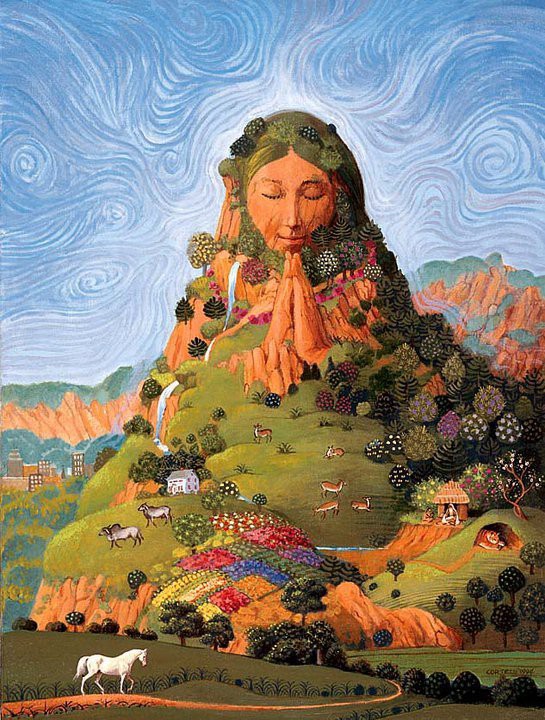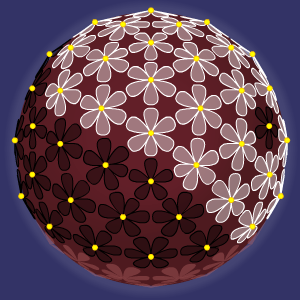
As you know, the modern idea of Gaia as a denizen of the Earth’s ecosphere was developed in the 1970s by James Lovelock together with Lynn Margulis. Then, it evolved in various versions and it was misunderstood in various ways. For instance, Toby Tyrrell wrote a whole booktrying to demonstrate that there is no such a thing as “Gaia.” He succeeded only at showing that one can write an entire book on something he doesn’t understand at all.
But it is true that some ways of understanding Gaia are untenable in light of what we know about biology. Sometimes we hear of Gaia described as a “superorganism” and sometimes as engaged in optimizing the ecosystem for living beings. That’s no good, as explained, for instance in a 2003 text by Victor Gorshkov and Anastassia Makarieva where they correctly note that, if Gaia is supposed to be a superorganism, then She cannot exist.
But, one moment. Who said that Gaia is a superorganism? Besides, what is a superorganism? The term is sufficiently vague that it can be badly misused and misunderstood. In general, it is intended as any assemblage of biological sub-units that don’t individually reproduce but rely on specialized organs for that. An eukaryotic cell is a superorganism, just as an ant colony. And if you, dear reader, are a human being, then you are a superorganism, too. But that doesn’t mean Gaia is one. For instance, I have in my hands right now Lovelock’s 1988 book “The Ages of Gaia” and I can’t find the term “superorganism” anywhere referred to Gaia.
Instead, Lovelock had a very clear idea of what Gaia is and he described that with his “Daisyworld” model, a highly simplified ecosystem consisting of daisies that can be black or white. Note that daisies are not two species, as it is stated very clearly in the book, they are a single species with a certain polymorphism in their pigmentation. The Gaian mechanism in Daisyworld consists in the daisies slight modifying the frequency of one of their alleles — that is the white pigment allele becomes more frequent — to cope with a gradual increase in the solar irradiation. They do that to maintain their optimal temperature but that also affects the environment. With more white daisies, the albedo of the planet increases, more sunlight is reflected back into space, and the planet cools down. This is rare in the real ecosystem, but some algae may use this strategy. (image from gingerboot.com)
The daisyworld model is one of those genial ideas that can be completely misunderstood. And it has been misunderstood: it has been seen as a toy, or as irrelevant to the real world, or simply meaningless. But be careful: you may say it is oversimplified, rough, wrong, whatever you want, but all models are wrong and at the same time all models are useful if you understand their limits. And that’s the case of Daisyworld a “level zero” model that opens up for us a completely new vision of how the Earth’s ecosystem – Gaia – works. A true stroke of genius on the part of James Lovelock, one of the most brilliant minds of our times.
In any case, for what we are discussing here, the point is that the daisies of Daisyworld are NOT a superorganism. They have nothing of the complex structure of sub-units that make a superorganism. They are just a population of loosely coupled individuals. In this case, they act on the environment by slightly modifying their genome, Lovelock had in mind a time scale of millions of years, so there was plenty of time for the genome to change. But that’s not a necessary condition, on a shorter time scale we don’t need to touch the genome to kick-start the Gaian mechanism. Here is how Gorshkov and Makarieva describe the concept they call “biotic regulation”
Let us suppose that the living objects capable of environmental control are trees, while the regulated global environmental characteristic is atmospheric carbon dioxide concentration. Suppose further that in the course of a major atmospheric disturbance (volcanic eruption, anthropogenic activities) the global atmospheric carbon dioxide concentration becomes significantly higher than the biotic optimum. All trees on the tree-covered planet are thus faced with approximately equal unfavourable environmental conditions. Normal trees immediately begin to work on removing the excessive carbon from the atmosphere in order to restore the optimum concentration of carbon dioxide. This can be done, for example, by depositing the excessive atmospheric carbon in organic form in soil and sediments.
A different Gaian mechanism may not involve the biosphere alone but the whole metasystem formed of the linked geosphere, atmosphere, and biosphere. It is the case of the geological carbon cycle that seems to have been fundamental in keeping the Earth’s temperature approximately constant over a time scale of hundreds of millions of years, as I described in a previous post.
None of these mechanisms imply centralized control, altruism, intelligence, planning, or things like that – no superorganism whatsoever. And here She is: Gaia appearing to us. It is an emergent property of the ecosystem that results from internal feedbacks that tend to keep the system in a homeostatic condition.
Names have the meaning we want to give them: We can say that Gaia is “just” an ecosystem, that she is not a Goddess at all, in the sense that she is definitely not benevolent and merciful, that she is not to be worshipped (of course not!). But there exists also the concept of “reverence” defined as “a feeling or attitude of deep respect tinged with awe.” Reverence might be an appropriate attitude towards an enormously powerful creature which (who) can squash humankind into pulp in no time.
And if you don’t revere — worse, if you despise — the Goddess, woe betide you: the ancient recognized the concept of hubris (ὕβρις) leading to Nemesis (Νέμεσις), the Goddess of vengeance, providing the appropriate retribution to those guilty of overconfidence. Maybe Nemesis is just another name for Gaia, but, eventually, we don’t need an angry Goddess to destroy humankind, we seem to be perfectly able to do that ourselves. In the end, it is all in the hands of the Moirai (Μοῖραι) who spin the thread of destiny in their hands.










































